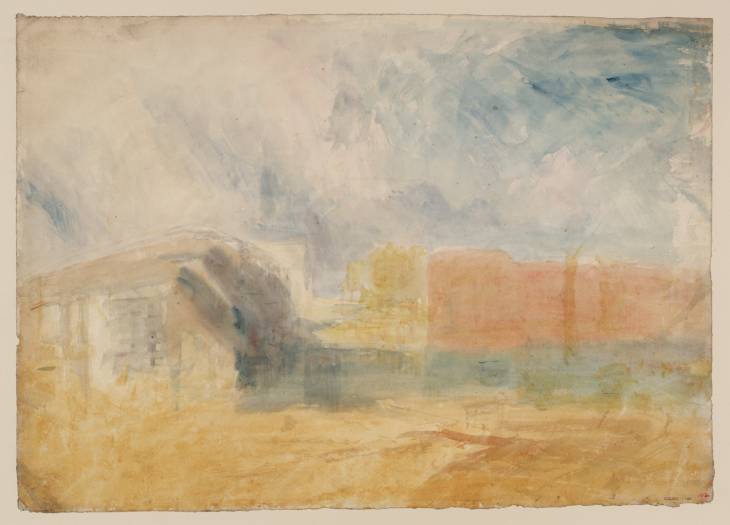Joseph Mallord William Turner Hampton Court Bridge, with Houses on the River Bank c.1827
Joseph Mallord William Turner,
Hampton Court Bridge, with Houses on the River Bank
c.1827
Joseph Mallord William Turner 1775–1851
Hampton Court Bridge, with Houses on the River Bank c.1827
D25224
Turner Bequest CCLXIII 102
Turner Bequest CCLXIII 102
Watercolour on white wove paper, 342 x 481 mm
Inscribed in red ink ‘102’ bottom right
Blind-stamped with Turner Bequest monogram towards bottom right
Stamped in black ‘CCLXIII – 102’ bottom right
Inscribed in red ink ‘102’ bottom right
Blind-stamped with Turner Bequest monogram towards bottom right
Stamped in black ‘CCLXIII – 102’ bottom right
Accepted by the nation as part of the Turner Bequest 1856
Exhibition history
2008
¿¿¿¿¿¿ [Turner] (1775–1851), Pushkin Museum of Art, Moscow, November 2008–February 2009 (63, reproduced in colour, as ‘Hampton Court Bridge, with Houses on the River Bank’, c.1827).
2009
Turner from the Tate Collection, National Art Museum of China, Beijing, April–July 2009 (63, reproduced in colour, as ‘Hampton Court Bridge, with Houses on the River Bank’, c.1827).
References
1909
A.J. Finberg, A Complete Inventory of the Drawings of the Turner Bequest, London 1909, vol.II, p.822, CCLXIII 102, as ‘Wooden bridge, with houses on river bank’. c.1820–30.
1991
Ian Warrell, Turner: The Fourth Decade: Watercolours 1820–1830, exhibition catalogue, Tate Gallery, London 1991, p.47 under no.40.
1997
Eric Shanes, Turner’s Watercolour Explorations 1810–1842, exhibition catalogue, Tate Gallery, London 1997, pp.27, 96 Appendix I under ‘England and Wales Series’, as ‘Sketch for a view of Old Chelsea Bridge’. c.1832, p.102 under ‘Thames Views’, as ‘Old Chelsea Bridge’. c.1832, p.105 Appendix II, as ‘Sketch: Old Chelsea Bridge’.
2008
Ian Warrell, in Anna Poznanskaya, Warrell, Mathew Imms and others, ¿¿¿¿¿¿ [Turner], exhibition catalogue, Pushkin Museum of Art, Moscow 2008, p.111 no.63, reproduced in colour, as ‘Hampton Court Bridge, with Houses on the River Bank’. c.1827.
2009
Ian Warrell in Fan Di’an, Warrell, Matthew Imms and others, Turner from the Tate Collection, exhibition catalogue, National Art Museum of China, Beijing 2009, p.104 no.63, reproduced in colour, p.176, as ‘Hampton Court Bridge, with Houses on the River Bank (also known as Old Chelsea (or Battersea) Bridge, with Houses on the River Bank)’. c.1827.
Ian Warrell first related this colour study to a pencil drawing of ‘a wooden bridge’, by implication on the River Thames, in the Isle of Wight sketchbook (Tate D20798; Turner Bequest CCXXVII 40a), in use on the island in 1827 but also including sketches which informed the watercolour of the Thameside Hampton Court Palace of about 1827 (private collection),1 engraved in 1829 for the Picturesque Views in England and Wales (Tate impressions: T04550).2 Sketches elsewhere in the same book formed the basis of another colour study of the river at nearby Hampton (Tate D25145; Turner Bequest CCLXIII 23).
Eric Shanes subsequently linked the present study to Old Chelsea Bridge,3 picking up on Finberg’s description of the related Isle of Wight sketch as ‘River scene: Wooden bridge with stone supports, boats and figures (seated) in foreground. Possibly Old Chelsea Bridge’.4 By this Finberg meant Old Battersea Bridge, linking Battersea to Chelsea, as seen in the background of Turner’s copy-drawing of about 1797 (Tate D00857; Turner Bequest XXXII A), and in 1870s paintings by Walter Greaves (1846–1930) and James Abbott McNeill Whistler (1834–1903) (respectively Tate N04598 and N01959). However, that bridge had wooden piers reinforced above water level with lattices of timbers, whereas Turner’s pencil sketch (D20798) shows solid supports, apparently with timberwork above.
Warrell has since identified the bridge as that at Hampton Court,5 just upstream of the palace. This is confirmed by a watercolour inscribed ‘Hampton Bridge’ by Thomas Rowlandson (1756–1827) showing an almost identical view to Turner’s pencil study, with the bridge springing from enclosed timber piers on the left and the same buildings on the right on the far bank (Victoria and Albert Museum, London).6 The main elements of Turner’s detailed sketch have been translated directly into the colour structure set out in the present work. The bridge has since been replaced and the buildings have not survived.
Warrell notes that Tate D20793 (Turner Bequest CCXXVII 38), a rough tonal pencil study on a page in the Isle of Wight sketchbook prepared with grey wash, shows the same view as D20798. He suggests that the colours in the present work, ‘together with the suggestion of a blustery, cumulus-filled sky’ are comparable with those in the finished Hampton Court Palace, ‘suggesting that the two watercolours were almost certainly painted as part of the same working session’.7
See also the introductions to the present subsection of identified but unrealised subjects and the overall England and Wales ‘colour beginnings’ grouping to which this work has been assigned.
See also variant reproduced as ‘1790: Second Hampton Court Bridge (1778–1866), print by Thomas Rowlandson’ at ‘Hampton Court Bridge’, Where Thames Smooth Waters Glide, accessed 19 March 2013, http://thames.me.uk/s00370.htm .
Verso:
Blank save for registrars’ inscriptions, but laid down and not examined directly.
Blank save for registrars’ inscriptions, but laid down and not examined directly.
Matthew Imms
March 2013
How to cite
Matthew Imms, ‘Hampton Court Bridge, with Houses on the River Bank c.1827 by Joseph Mallord William Turner’, catalogue entry, March 2013, in David Blayney Brown (ed.), J.M.W. Turner: Sketchbooks, Drawings and Watercolours, Tate Research Publication, December 2013, https://www

